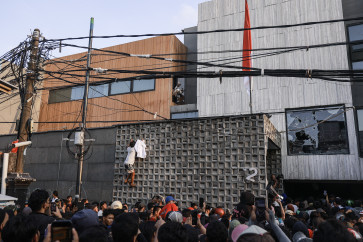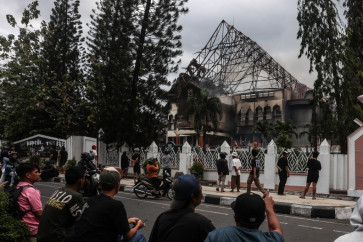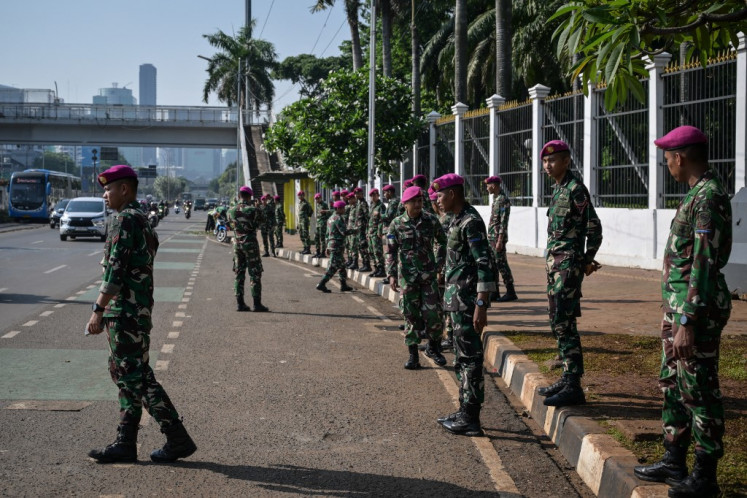Popular Reads
Top Results
Can't find what you're looking for?
View all search resultsPopular Reads
Top Results
Can't find what you're looking for?
View all search resultsRising sea levels threaten 2,000 islands in Indonesia
Last legs: Traditional rumah panggung (wooden-stilt houses) in a fishing village in Palopo, South Sulawesi
Change text size
Gift Premium Articles
to Anyone
 Last legs: Traditional rumah panggung (wooden-stilt houses) in a fishing village in Palopo, South Sulawesi. Experts predict that before 2050, thousands of small islands and millions of houses in coastal areas across Indonesia will disappear due to rising sea levels caused by climate change. (thejakartapost.com/Elly Burhaini Faizal) (wooden-stilt houses) in a fishing village in Palopo, South Sulawesi. Experts predict that before 2050, thousands of small islands and millions of houses in coastal areas across Indonesia will disappear due to rising sea levels caused by climate change. (thejakartapost.com/Elly Burhaini Faizal)
Last legs: Traditional rumah panggung (wooden-stilt houses) in a fishing village in Palopo, South Sulawesi. Experts predict that before 2050, thousands of small islands and millions of houses in coastal areas across Indonesia will disappear due to rising sea levels caused by climate change. (thejakartapost.com/Elly Burhaini Faizal) (wooden-stilt houses) in a fishing village in Palopo, South Sulawesi. Experts predict that before 2050, thousands of small islands and millions of houses in coastal areas across Indonesia will disappear due to rising sea levels caused by climate change. (thejakartapost.com/Elly Burhaini Faizal)
L
span class="caption">Last legs: Traditional rumah panggung (wooden-stilt houses) in a fishing village in Palopo, South Sulawesi. Experts predict that before 2050, thousands of small islands and millions of houses in coastal areas across Indonesia will disappear due to rising sea levels caused by climate change. (thejakartapost.com/Elly Burhaini Faizal)
An expert has warned that rising sea levels caused by climate change need to be considered in development planning as 2,000 islands and 42 million homes are on track to be submerged before 2050.
'According to experts, there will be a sea level rise of up to 90 centimeters by 2050, which could drown 2,000 small islands in Indonesia,' Maritime Affairs and Fisheries Ministry public policy specialist Achmad Poernomo said as quoted by Antara in Jakarta on Wednesday.
Around 42 million homes located in coastal areas were at risk of drowning, he added.
The expert was speaking during the launch of the climate change mitigation and adaptation study program at Gadjah Mada University's (UGM) Graduate School in Yogyakarta.
'Rising sea levels is one of the disaster risks that has emerged as a result of climate change,' said Poernomo.
Uncertain fishing seasons, changes in fish migration patterns and increasing numbers of fish washed up on beaches were other impacts of climate change, he added.
Poernomo said disasters resulting from climate change must be jointly tackled and anticipated by the government and all of society by supporting sustainable development programs.
'The fisheries and maritime affairs minister [Susi Pudjiastuti] has written a letter, asking all regional heads to manage natural resources sustainably,' said Poernomo.
Sudibyakto, from UGM's Disaster Management master's program said almost 85 percent of disasters in Indonesia were closely related with climate change-related phenomena.
Despite being at high risk of disaster, he said, Indonesia had limited human resources in the field of disaster mitigation.
'The number of available human resources with expertise in disaster mitigation is not proportional to the level of disaster risks in the country,' said Sudibyakto.
He said that to tackle that imbalance, in the field of disaster management, Indonesia needed to produce 1,500 bachelor's degree graduates, 250 master's degree holders and 50 PhD graduates within the next 15 years.
Sudibyakto said that apart from a shortage of skilled human resources, commitments by local administrations to allocate funds for disaster mitigation programs were still limited and they had not yet included higher disaster budgetary allocations in their priority lists.
'This reality has caused many disaster-risk reduction activities and programs at the local level to be not well planned or implemented,' he said. (liz/ebf)(+)









